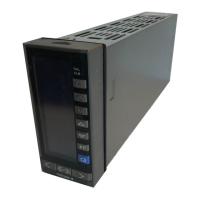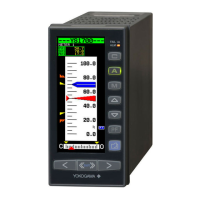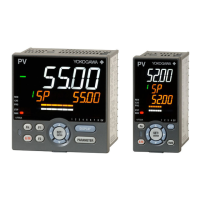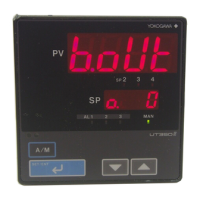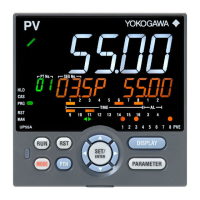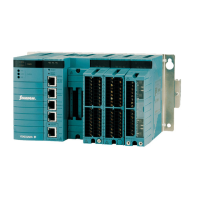27
IM 01B08B02-01EN
Monitoring and Control of
Regular Operations
Monitoring and Control of Regular Operations (Operation Display)
Table 5.14
No. in
Figure
Name Description
(4)
Alarm item
System Alarms
Display Description
[X1]to[X8] InputoverrangeRegisternamesX1toX8thathavebeenallocated
to each input terminal are displayed.
[Y1] and [Y3]
Output open (current output only) Register names Y1 and Y3 are displayed.
[CALC] Computation overflow (only in the YS1700 programmable mode)
[OVER]
Exceeding of control period (only in the YS1700 programmable mode)
[COMM] RS-485 communication error, DCS-LCS communication error, or
peer-to-peer communication error
[ETHER] Ethernet communication error
[PTOP] Peer-to-peer communication error
[PROG] User program error
[DATA] YSS1000 writing incomplete
[CALR] Adjustment inspection error
Event indication
Display Description
[EVENT1] to
[EVENT5]
User-set events 1 to 5
(5)
Unacknowledged
alarm marks
For unacknowledged alarms, [*] is indicated in front of alarm items.
(6)
Operation status
display
The controller operation status is displayed.
Display Description
Display
Priority Order
[POWER DOWN] Power down is being detected. (1)
[H.MAN] Hard manual selector switch has been activated. (2)
(No indication) The instrument is operating.
(3)
[STOP] Operation stopped (such as while setting a function
on the Engineering Display, etc.)
[TEST1] Test run mode 1 (only in the programmable mode)
[TEST2]
Test run mode 2 (only in the programmable mode)
Simulation program is being executed
(7)
Alarm lamp Lights up if a process alarm, STC alarm, or system alarm occurs.
(8)
Software key function
display
Indicates that the [ALM CLR] software key is allocated to the key, the [EVT ON] software key to
the key,the[↓]softwarekeytothe key, and the [EVT CLR] software key to the key.
► Foroperation:seethefollowing“OperatingtheALARMDisplay.”
(9) MV display
MV bar, MV scale, MH pointer, ML pointer, MV underflow, MV overflow, and MV valve direction
are displayed. The display contents are the same as those of the LOOP Display.
Operating the ALARM Display
The following operations can be conducted on the ALARM Display:
(1) MV operation (the same as that of the LOOP Display)
(2) Acknowledgement of unacknowledged alarms/events
(3) Re-display of event indication
● Acknowledgingunacknowledgedalarms/events
The Alarm [ALM CLR] software key is used to acknowledge that an alarm has occurred. When this key is pressed, the “*” mark that indicates that the alarm concerned
has not yet been acknowledged, and that indicates currently not occurring alarms will be erased, implying that the alarm(s) has been acknowledged.
The Event [EVT CLR] software key is used to acknowledge an event. When this key is pressed, the “*” mark that indicates that the event concerned has not yet been
acknowledged, and that indicates events currently not generated will be erased, implying that the event(s) has been acknowledged.
● Re-displayingeventindication
Browsethroughtheeventlinesusingthe[↓]softwarekey( key) to select an event you wish to see and then press the [EVT
ON] software key ( key). This causes the event to be re-displayed.
C
*
Select a generated event using the [↓] software key ( key) then
press the [EVT ON] software key ( key). This causes the
generated event status (*) to be displayed.
Press the [EVT CLR] software key ( key), and then clears the
selected generated event status (*).
0505E.ai
Select an event.
Figure 5.5
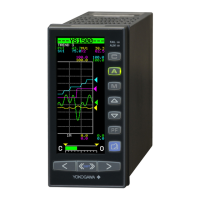
